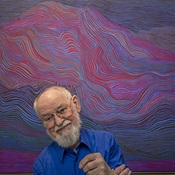Julian Stanczak (1928-2017)
Sectional Composite, 1981
(Set of 5 prints: A = edition no. 64/75, B = edition no. 60/75, C = edition no. 60/75, D = edition no. 66/75, and E = edition no. 60/75)
Materials: Color silkscreen printed on paper, each 37" x 16”
Location at Summa Health: Dr. Gary B. and Pamela S. Williams Tower, Akron Campus (141 N. Forge St.), Blue Neighborhood, First Floor, H Elevator Lobby
About the Art

Julian Stanczak’s Sectional Composite exemplifies his masterful use of color and geometry to create vibrant, perceptually engaging compositions. A pioneer of Optical Art (Op Art), Stanczak developed a signature approach that used intricate color relationships and precise geometric arrangements to explore how color interacts with light and the human eye. His work is not just visual; it’s experiential, generating dynamic optical effects that make the forms seem to shift and vibrate.
This five-part screenprint series highlights Stanczak’s deep understanding of color theory, using carefully calibrated hues to create contrast, depth, and energy. The print medium allows for the creation of multiples, with each edition numbered to indicate its sequence in the production process. In this case, Sectional Composite was printed in an edition of 75, with Summa’s set featuring prints numbered between 60 and 66, making them among the final impressions pulled from the press. The prints were produced by Vistec Graphics in Rochester, NY, under the commission of Eugene Schuster.
About the Artist

Born in Poland, Stanczak endured profound hardships during World War II before emigrating to the United States. After earning his Master of Fine Arts from Yale University, he settled in Ohio, where he became a celebrated educator and artist. His groundbreaking 1964 exhibition in New York, Optical Paintings, led to the naming of the Op Art movement, though he preferred the term perceptual abstraction to describe his work. His meticulous technique and ability to create visual depth and motion through color earned him international recognition, yet his approach remained deeply personal; his art was an exploration of perception, emotion, and the sensory experience of color.
Despite an injury to his dominant right arm as a young man, Stanczak retrained himself to paint and draw with his left hand. This determination and discipline are evident in the precise, complex compositions that define his career. Beyond his teaching tenure at the Cleveland Institute of Art, Stanczak continued creating art that influenced generations of artists and scholars.
Where You Can See More of Stanczak’s Work
Stanczak’s work is held in major museum collections across the United States and internationally. In Northeast Ohio, his legacy is particularly strong. His monumental 14-story mural City Canvas at Carter Manor (now Winston Manor) at the corner of Prospect and East 9th Street in downtown Cleveland was recreated for the 2018 FRONT International Cleveland Triennial for Contemporary Art. His paintings and prints can be found in galleries in Ohio, New York, and Los Angeles, as well as in many esteemed museum collections worldwide.
For a deeper look into his life, creative philosophy, and extensive body of work, visit his official website, where archival materials, interviews, and a chronological gallery of his art provide insight into his groundbreaking contributions to contemporary art.
